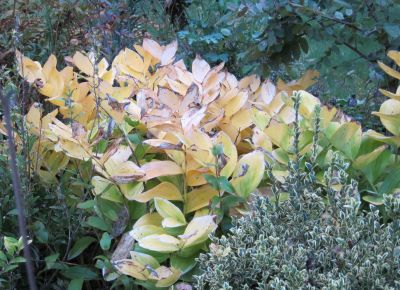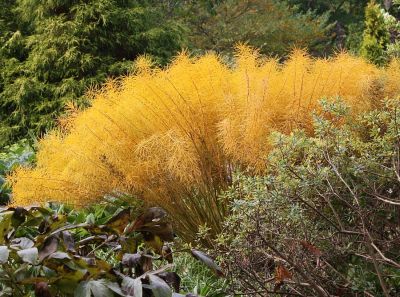We usually look up to the trees for the spectacle of fall foliage color but there’s plenty happening down low. Ornamental grasses in autumn are, of course, amazing – I think I’ll give them a post of their own. But there are a few perennials that consistently deliver good fall color instead of turning to brown, crunchy paper.
For the shade to part-shade garden, Polygonatum odoratumthen ‘Variegatum’ is a plant for three seasons. Arching stems
spring forth in, well, Spring, with fresh green and white variegated
foliage. Pairs of little creamy bell-like flowers dangle from each leaf
node. The foliage looks terrific all summer long, and you get a shot of golden yellow for fall.

More reliable than a tulip poplar! Newport, VA, October 10.
I know I’ve mentioned Amsonia hubrichtii in some past posts, but I just can’t help it. Finally, finally named “Perennial Plant of the Year ” for 2011 by the Perennial Plant Association. Not sure what took so long. Exhibits the best boofy habit of all perennials (somewhat like “floofy”, but rounder). Native to southern/central U.S. and totally drought tolerant. The pale blue star-shaped flowers in late Spring are fairly underwhelming, especially given all the other stuff going on at the time. The fine, needle-like foliage adds a wonderful soft texture throughout the summer. As the days shorten and the nights cool down, it begins to glow…first a soft gold, and then adds bronze and apricot to the mix – basically a color twin of Sporobolis heterolepis (Prairie Dropseed, previously described in a GP post).

The first flush of gold, just getting going in our garden last week…

In full glory. Late fall at Chanticleer (Radnor, PA).
Some cultivars of Hosta, such as ‘Sum & Substance’, reliably produce gold fall color, as do some ferns. Any others you’d like to add to list?
That Amsonia is amazing! Do the native Polygonatums offer the same fall color? I’m not a native-only gardener, but I do select them when I can. I am currently constructing a native plant area on the shady side of my backyard.
I’d like to add Geranium sanguinium and most of the Bergenias. They add nice reds.
That foliage and color are simply beautiful. I think I saw it planted somewhere this spring, but had no idea the foliage would look like this in the fall.
Muhlenbergia capillaris. It’s an ornamental grass that geta about 1 1/2′ tall. In the fall (now in 6B lower NY) it sends up lacy, ethereal looking purple blooms. I’ve had it for several years and need to move it so it has a good backdrop that will show off the blooms. I found this photo: http://www.gatewaygardens.com/_ccLib/image/plants/DETA-375.jpg
Though a woody plant, it’s low enough to be a perennial; Mahonia repens has great red fall color. All of my peonies get great orange-red fall color. Schizachyrium scoparium is my favorite grass for fall color, the orange and burgundy tones in conjunction with the seed heads are spectacular.
I do have a complaint about A. hubrichtii- chlorosis. It’s an annual problem here and pH changes, chelated iron, and nitrogen don’t seem to help. Any answers?
Nick, that’s a new one on me (chlorosis). Where is “here”?
Val, I took a walk through our woods to specifically to check out fall color on the native P. biflorum and they’re still green. Will report back later!
I’m with Nick on a couple of plants — my peonies are a good muted russet/gold right now, and Schizachrium scoparium has such great fall color, with a continuing presence through the winter (The cultivar ‘The Blues’ is particularly striking.) For actual bloom even at this late date in MA (where I am we haven’t gotten frost yet), I have a clump of Korean chrysanthemum going strong, an arbor covered with Ipomaea x multifida (Cardinal Vine) that reliably puts out cherry red blooms every day, a reblooming rose (don’t know the name, but gold and apricot mute down into a pale pink over the course of a week) is blooming nicely, and a bed of nasturtiums that looks as if it’s forgotten that winter is coming. Those fall blooming plants — the ones that go on even after aster and goldenrod have gone by — are also really valuable.
Ceratostigma wilmottianum ‘My Love’, Hypericum ‘Brigadoon’, and Sedum ‘Angelina’ all have yellow foliage that gets distinct orange tints with cool temps and short days. Cerat plumbag has terrific maroon fall color. Penstemon ‘Dark Towers’ can have fiery red fall color, but only the leaves on the flower stalks in my experience. Miscanthus purpurascens (sp?) is a fall foliage dynamo. Some of the Heuchera, Heucherella, and Tiarella experience beautiful color changes in fall – check out ‘Electric Lime’, ‘Golden Zebra’, ‘Miracle’, and ‘Tiramisu’ (not as familiar with the Tiarellas…sorry). I’ve seen stunning fall color on Lysimachia clethroides, but I dared not stand too close lest it eat me while I admired it. Oh! And some of the other groundcover Sedums turn in the winter…I’ve seen Weihenstephaner Gold (normally green) turn beet red in winter. And I can’t believe I almost forgot Euphorbias…the new Ascot Rainbow is a house on fire in winter! Euphorbia Rudolph isn’t bad either – the newest growth on both turns reddish burgundy in fall. YOWZA! This was fun 🙂 Can we do off season bloomers next? Can we? Can we? D’oh! One more…not a striking color per se, but Sasa veitchii (sp) has stunning foliage in winter thanks to its oddball marginal drying habit. Okay, I’m done…for now 🙂
Holly, here is SE WI. Chlorosis has been a problem in soils that are pretty good loam to heavy clay. I’ve heard people complain of the problem in other areas of the upper midwest as well.
I’d like to point out to our audience that Paul W. does a very thorough and enthusiastic talk on herbaceous plants for autumn interest. If you’d like to book him for your organization or event, let me know 😉
Nick – you’ve just given me a terrific idea for a little research project. Awesome.
Y’all who mentioned grasses got ahead of the game – I said “that’s for another post” ha ha! You’ll get your Schizachyrium soon! And off-season bloomers too, for Deb and Paul.
LOVE this plant!..http://thlandscapedesign.blogspot.com/